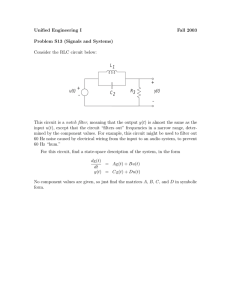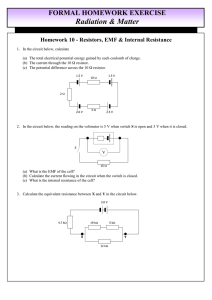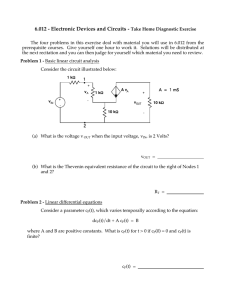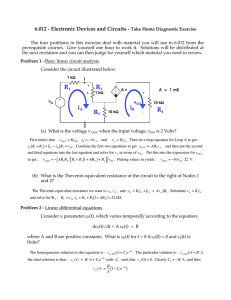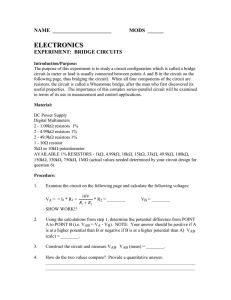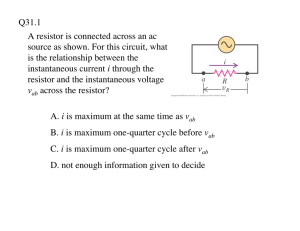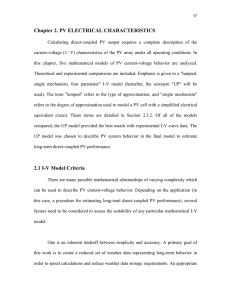Document 13479329
advertisement
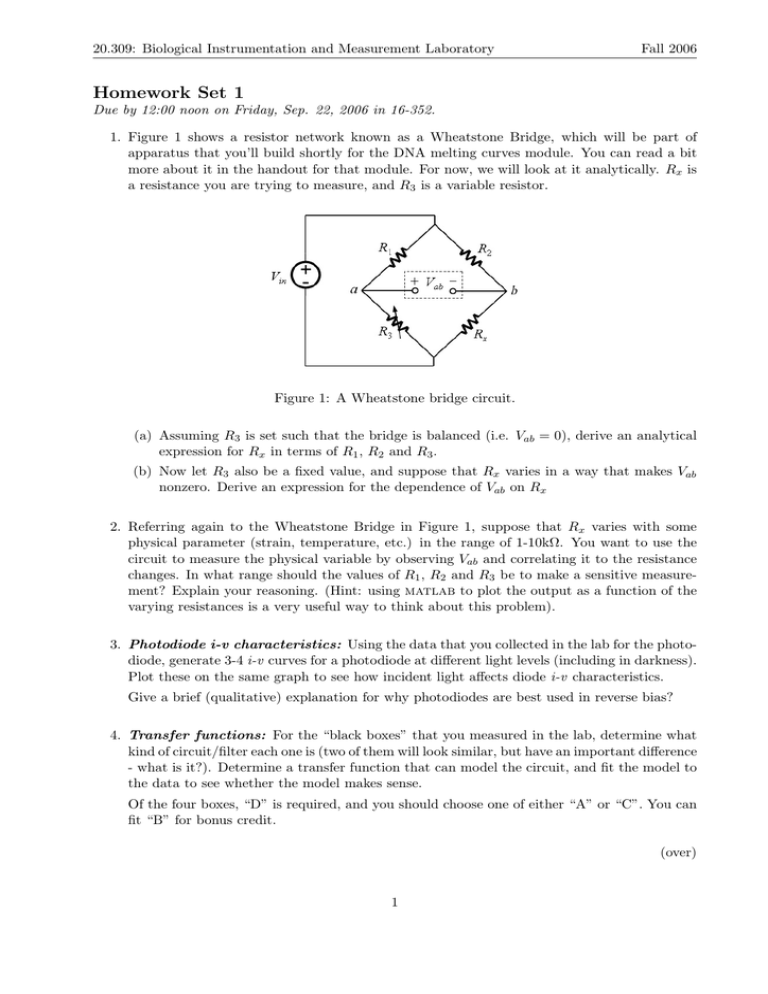
20.309: Biological Instrumentation and Measurement Laboratory Fall 2006 Homework Set 1 Due by 12:00 noon on Friday, Sep. 22, 2006 in 16-352. 1. Figure 1 shows a resistor network known as a Wheatstone Bridge, which will be part of apparatus that you’ll build shortly for the DNA melting curves module. You can read a bit more about it in the handout for that module. For now, we will look at it analytically. Rx is a resistance you are trying to measure, and R3 is a variable resistor. Figure 1: A Wheatstone bridge circuit. (a) Assuming R3 is set such that the bridge is balanced (i.e. Vab = 0), derive an analytical expression for Rx in terms of R1 , R2 and R3 . (b) Now let R3 also be a fixed value, and suppose that Rx varies in a way that makes Vab nonzero. Derive an expression for the dependence of Vab on Rx 2. Referring again to the Wheatstone Bridge in Figure 1, suppose that Rx varies with some physical parameter (strain, temperature, etc.) in the range of 1-10kΩ. You want to use the circuit to measure the physical variable by observing Vab and correlating it to the resistance changes. In what range should the values of R1 , R2 and R3 be to make a sensitive measure­ ment? Explain your reasoning. (Hint: using matlab to plot the output as a function of the varying resistances is a very useful way to think about this problem). 3. Photodiode i-v characteristics: Using the data that you collected in the lab for the photo­ diode, generate 3-4 i-v curves for a photodiode at different light levels (including in darkness). Plot these on the same graph to see how incident light affects diode i-v characteristics. Give a brief (qualitative) explanation for why photodiodes are best used in reverse bias? 4. Transfer functions: For the “black boxes” that you measured in the lab, determine what kind of circuit/filter each one is (two of them will look similar, but have an important difference - what is it?). Determine a transfer function that can model the circuit, and fit the model to the data to see whether the model makes sense. Of the four boxes, “D” is required, and you should choose one of either “A” or “C”. You can fit “B” for bonus credit. (over) 1 20.309: Biological Instrumentation and Measurement Laboratory Fall 2006 5. Referring to the circuit shown in Figure 2, what value of RL (in terms of R1 and R2 ) will result in the maximum power being dissipated in the load? (Hint: this is much easier to do if you first remove the load, and calculate the equivalent Thevenin output resistance RT of the divider looking into the node labeled Vout . Then express RL for maximal power transfer in terms of RT .) Figure 2: A voltage divider formed by R1 and R2 driving a resistive load RL . 6. Consider the op-amp circuit shown in Fig. 3. Figure 3: (a) Determine an expression for the output voltage of the circuit with respect to a DC current input. Express your answer in Vout /Iin . (b) Since this is such a high-gain circuit, it can be quite noisy, if the input current Iin experiences high-frequency fluctuations. You can insert a capacitor across one of the resistors to reduce the noise (i.e. make a low-pass filter to eliminate high-frequency content). Where would you insert it, and how would you choose its size? (c) Now write down the expression for this new circuit’s output with respect to the current input for AC signals (Hint: in the expression from part (a), substitute the parallel combination Rx � C for the resistor Rx that you chose). 2

